Audi R8 Spyder (2016-2023) engines, drive and performance
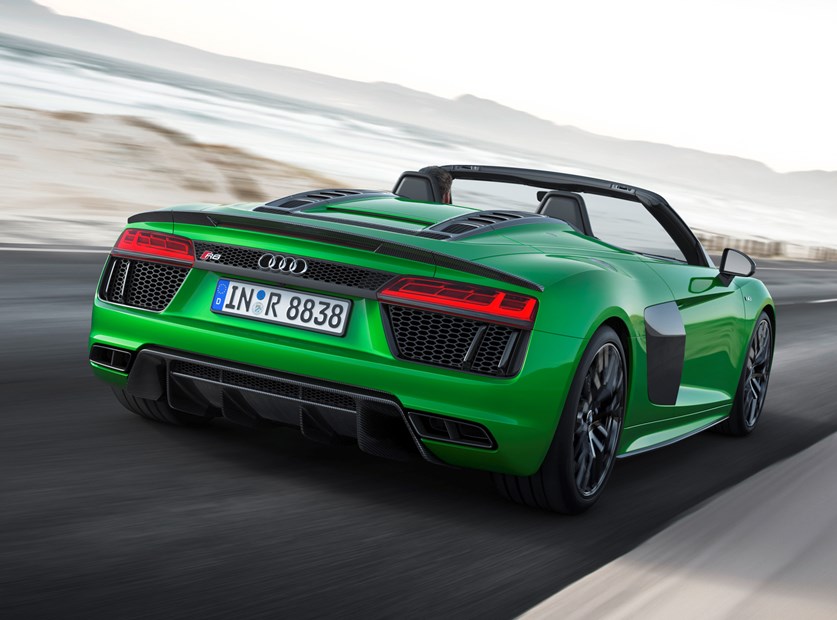
- Top-drawer acceleration, 200mph maximum speed
- V10 soundtrack to die for – revs to 8,400rpm
- Huge performance, but easy to drive slowly
The standout feature of the Audi R8 Spyder is undoubtedly its stunning naturally-aspirated 5.2-litre V10 petrol engine. In a world increasingly dominated by V8 and V6 turbos, it’s a breath of fresh air for car enthusiasts. It makes a sensational noise, too. The Audi R8 V10 Spyder essentially comes in two forms – the ‘standard’ Quattro model and the ‘V10 Performance’ version. Both types of R8 Spyder are more powerful and faster than their predecessors.
Spec highlights V10 Quattro:
- 570hp, 560Nm, 3.5sec 0-62mph, 200mph top speed, 20.9-21.2mpg (Combined WLTP), 297g/km CO2
Audi has created a truly brilliant power unit for the R8 – and all the better for not having a turbo to dull the responses and make it quieter. One thing that’s clear is that the engine responds super-quickly to throttle inputs, and as a consequence, it feels extremely lively.
Power comes in relentless shrieks of brutal forward momentum. There are no spikes in the power curve, and no points where you’d be waiting for a turbo to boost – it’s a constant flow of power barely punctuated by laser-fast gear shifts from the seven-speed S tronic twin-clutch automatic gearbox. That latter feature is at its best handling gearshifts itself, but you’re able to take control using paddles mounted on the back of the steering wheel. Unlike many rival transmission set-ups (including DSGs in other Audis), once you select a gear manually, it’s reluctant to return to auto mode.
Audi R8 Spyder: easy to drive slowly
Perhaps as impressive as the outright speed this car will achieve is how easy it is to drive slowly. If you’re light on the accelerator pedal and want to move at less than warp speed, the R8 Spyder feels just like any other Audi, albeit louder. You can tickle the throttle, and just roll along with the rest of the traffic, and unlike many other supercars, it won’t egg you on to drive it fast.
But it’s there when you want to. You’re able to sharpen the R8’s character significantly with the built-in drive modes, which can be toggled using controls on the steering wheel. Choose between Comfort and Sport modes for throttle response, gearchange ferocity and engine noise, or choose your own configuration using the Individual setting.
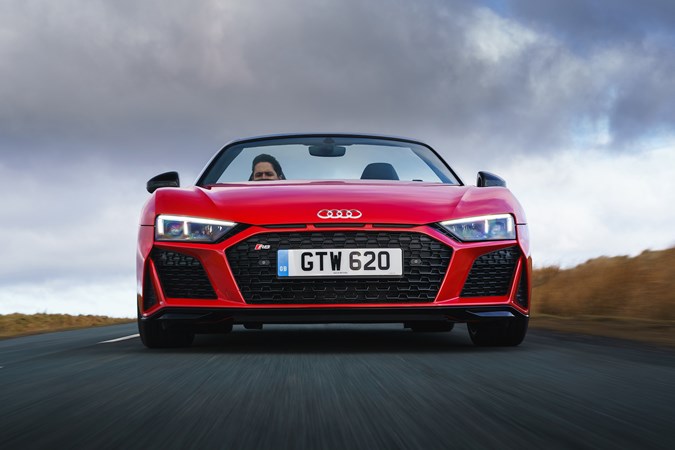
Audi R8 Spyder V10 Performance
This model replaces the old Plus version, launched in 2017. Audi says that 5.2-litre engine’s uplift in power is down to upgraded valvegear, and the liberal use of titanium. The net result is an additional 50hp over the V10 Quattro.
Spec highlights V10 Performance:
- 620hp, 580Nm, 3.2sec 0-62mph, 204mph top speed, 20.9-21.1mpg (WLTP combined consumption), 302g/km CO2
There are a few other tweaks, too, including even greater amounts of carbon trim, a fixed-rear spoiler, standard-fit bucket seats, more powerful ceramic brakes and switchable performance modes (in addition to Audi’s drive select function). The end result is a car which feels incrementally faster and more impressive than the regular R8 V10 Spyder, but not necessarily more exciting.
Floor the accelerator and the speedometer climbs up to licence-losing speeds (and well beyond) that little bit faster, while the kick in the back is fractionally more pronounced. Make no mistake, though, both Quattro and Performance versions of the R8 Spyder are stupendously quick.
- Fantastic grip, steering and handling
- All-wheel drive for all-weather peace of mind
- Specify adaptive suspension, not ceramic brakes
Like the standard R8, the open-topped Spyder’s handling is pretty much all you need in a road car. The structure and body are a work of art, fashioned from carbonfibre and aluminium, and have been designed for maximum stiffness. The result of this is the suspension is beautifully set-up and consistant, while the ride and handling are barely affected by losing the roof.
There is a small amount more body flex than the Coupe, which you would expect. This is only really noticeable only when cornering quickly on bumpy roads, or when the road is cambered and lumpy. This is a car that makes you feel confident and safe in all conditions – quite remarkable considering how fast it goes – and that is probably its finest achievement (aside from its magnificent V10 engine).
The 2019 R8’s suspension and steering have been tweaked, and Audi says it’s more precise than before. That rings true on the road. It might lack that final 10% of precision you’d find in a Lamborghini or Ferrari, but the R8 is hugely rewarding to drive quickly thanks to its huge levels of grip, poise and steering feel. Its Quattro all-wheel drive system might send most of its power to the rear wheels, but it’s never anything other than a faithful point-and-steer supercar. It also feels alive at real-world speeds, and offers the safety of being able to adjust the throttle mid-bend without fear of tipping it into a slide.
There’s a choice of handling modes here – Comfort, Auto, Dynamic and Individual – selected from the steering wheel. These alter the car’s characteristics based on the grip available so you can make the most of your R8 Spyder in all conditions.
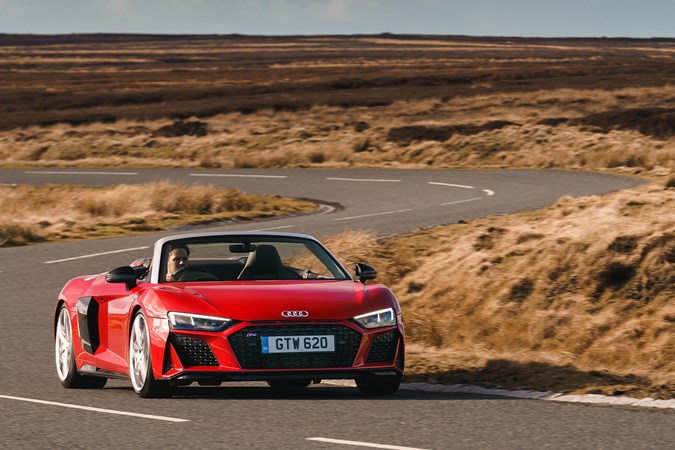
Options to pick and to avoid
We’ve yet to try the Dynamic steering set-up on the facelifted R8, but from previous expereice, weknow it can feel a little odd at first. This adjusts the weighting automatically based on your driving, and initially feels counter-intuitive. As with other versions of the R8, we found said steering to be surprisingly useful at lower speeds. Its turning circle is far smaller than other cars of this type, meaning you can manoeuvre in car parks very easily.
We can heartily recommend the Magnetic Ride adaptive suspension. Switched into its firmer setting the R8 Spyder has grip and composure you’ll never trouble on a public road without breaking the law. It’s mightily impressive in this regard.
On the other hand, the ceramic brakes are probably best avoided unless you’re going to wring every last horsepower from your R8 Spyder. They’re difficult to use at low speeds, making the drive a little jerky. They’re brilliant when used as intended, though – on a race circuit.



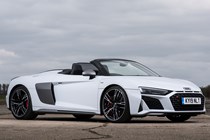
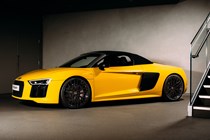
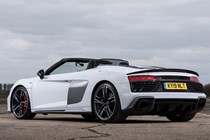
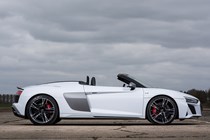
.jpg)
.jpg)
.jpg)
.jpg)
.jpg)
.jpg)
.jpg)
.jpg)
.jpg)
.jpg)
.jpg)
.jpg)
.jpg)
.jpg)
.jpg)
.jpg)
.jpg)
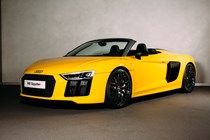
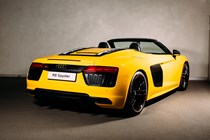
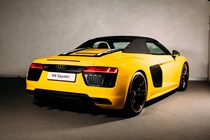


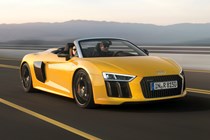
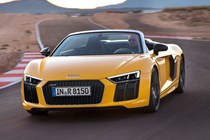
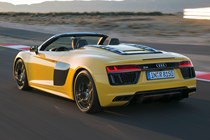
.jpg)
.jpg)
.jpg)
.jpg)
.jpg)
.jpg)
.jpg)
.jpg)
.jpg)
.jpg)
.jpg)
.jpg)
.jpg)
.jpg)
.jpg)
.jpg)
.jpg)
.jpg)
.jpg)
.jpg)
.jpg)
.jpg)
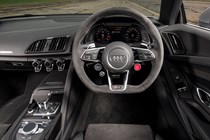
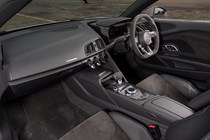
.jpg)
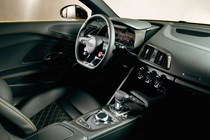
.jpg)
.jpg)
.jpg)
.jpg)
.jpg)
.jpg)
.jpg)
.jpg)
.jpg)
.jpg)
.jpg)
.jpg)
.jpg)
.jpg)
.jpg)
.jpg)
.jpg)
.jpg)
.jpg)
.jpg)
.jpg)
.jpg)
.jpg)
.jpg)
.jpg)
.jpg)
.jpg)
.jpg)
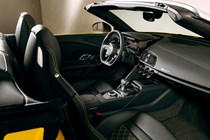
.jpg)
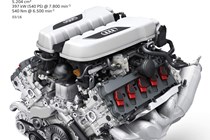
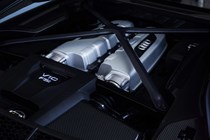





.jpg?quality=50)
.jpg?quality=50)
.jpg?quality=50)
.jpg?quality=50)
.jpg?quality=50)
.jpg?quality=50)
.jpg?quality=50)
.jpg?quality=50)
.jpg?quality=50)
.jpg?quality=50)
.jpg?quality=50)
.jpg?quality=50)
.jpg?quality=50)
.jpg?quality=50)
.jpg?quality=50)
.jpg?quality=50)
.jpg?quality=50)








.jpg?quality=50)
.jpg?quality=50)
.jpg?quality=50)
.jpg?quality=50)
.jpg?quality=50)
.jpg?quality=50)
.jpg?quality=50)
.jpg?quality=50)
.jpg?quality=50)
.jpg?quality=50)
.jpg?quality=50)
.jpg?quality=50)
.jpg?quality=50)
.jpg?quality=50)
.jpg?quality=50)
.jpg?quality=50)
.jpg?quality=50)
.jpg?quality=50)
.jpg?quality=50)
.jpg?quality=50)
.jpg?quality=50)
.jpg?quality=50)


.jpg?quality=50)

.jpg?quality=50)
.jpg?quality=50)
.jpg?quality=50)
.jpg?quality=50)
.jpg?quality=50)
.jpg?quality=50)
.jpg?quality=50)
.jpg?quality=50)
.jpg?quality=50)
.jpg?quality=50)
.jpg?quality=50)
.jpg?quality=50)
.jpg?quality=50)
.jpg?quality=50)
.jpg?quality=50)
.jpg?quality=50)
.jpg?quality=50)
.jpg?quality=50)
.jpg?quality=50)
.jpg?quality=50)
.jpg?quality=50)
.jpg?quality=50)
.jpg?quality=50)
.jpg?quality=50)
.jpg?quality=50)
.jpg?quality=50)
.jpg?quality=50)
.jpg?quality=50)

.jpg?quality=50)

